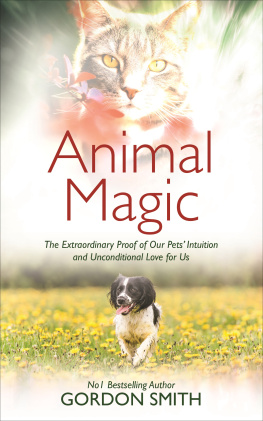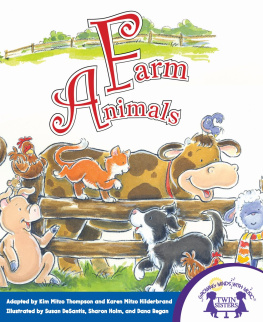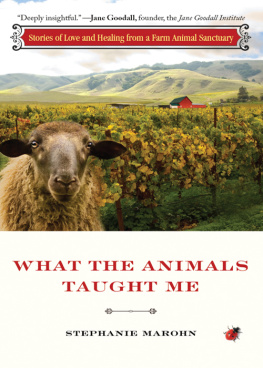Copyright 2014, Pam Chamberlain
All rights reserved. No part of this book may be reproduced, stored in a retrieval system or transmitted in any form or by any means without the prior written permission from the publisher, or, in the case of photocopying or other reprographic copying, permission from Access Copyright, 1 Yonge Street, Suite 1900, Toronto, Ontario M5E 1E5.
Nimbus Publishing Limited
3731 Mackintosh St, Halifax, NS B3K 5A5
(902) 455-4286 nimbus.ca
Printed and bound in Canada
NB1131
Cover and interior design: Jenn Embree
Library and Archives Canada Cataloguing in Publication
In the company of animals : stories of extraordinary encounters / editor, Pam Chamberlain.
Issued in print and electronic formats.
ISBN 978-1-77108-224-2 (pbk.).ISBN 978-1-77108-225-9 (html).
1. AnimalsAnecdotes. 2. Animal behaviorAnecdotes.
3. Human-animal relationshipAnecdotes.
I. Chamberlain, Pam, 1970-, editor
PS8323.A5I5 2014C813.0108362C2014-903178-5
C2014-903179-3
Nimbus Publishing acknowledges the financial support for its publishing activities from the Government of Canada through the Canada Book Fund (CBF) and the Canada Council for the Arts, and from the Province of Nova Scotia through Film & Creative Industries Nova Scotia. We are pleased to work in partnership with Film & Creative Industries Nova Scotia to develop and promote our creative industries for the benefit of all Nova Scotians.
to
the ones who taught me to love animals
my father
Ralph George Chamberlain
and
my grandmother
Kathleen (Bunny) Chamberlain, ne Rackham
(19131998)
Contents
Introduction
A nimals fascinate us. We decorate our babies nurseries with images of birds and bunnies. We read our children stories about a bear named Pooh and a pig named Wilbur. We drive Broncos, Beetles, and Rams, and we cheer for the Blue Jays, the Tiger-Cats, and the Lions. Animals and their images surround us.
I grew up on a farm in the company of animals. There were cows, horses, sheep, pigs, rabbits, and all kinds of poultry in the farmyard. Barn cats and cattle dogs roamed freely. Beyond the farmyard, in the pastures and in the bushes, there were coyotes, deer, black bears, foxes, jackrabbits, badgers, porcupines, skunks, and plenty of gophers. There were hawks, owls, crows, magpies, grouse, grosbeaks, and many little birds I couldnt name.
I loved animals. I loved to tame and snuggle kittens and rabbits. I had no qualms about picking up the tiger salamanders that lived in our dirt cellar. We all learned to ride horses, and when I was eleven, my grandmother gave me the gift of a lifetime: a palomino mare named Brena. I rode barebackI loved the physical connection between Brena and me. I rode whenever I could: with my dad to move cattle, with my grandma to pick wild crocuses or to picnic by the dam, and with my friend Hannah, whose family raced chuckwagons and who was an excellent rider. What I lacked in horsemanship skills, I made up for in enthusiasm.
As a teenager, I helped my dad with our sheep herd. One spring, a ewe was injured while birthing a large lamb, and she gave up on caring for it. Dad tried to get the lamb to suck, but the ewe was wild, ill, and uncooperative, and Dad eventually gave up too. Two hundred other animals on the farm needed his attention. I wouldnt give up, though. I cornered the ewe in a stall in the barn, pinned her neck against the rails with my left elbow, pressed the crown of my head into her flank to keep her still, and with my right hand, guided the baby toward the teat. I repeated this daily until eventuallyoh joy!the lamb was strong enough to suck on her own, and the mother was well enough to let her. Id spent hours in the barn and I had ticks in my scalp, but I was thrilled to know that II!had saved the life of a lamb. Dad rewarded me by giving me the lamb, whom I named Julia, and I had the beginning of my own sheep herd.
My mom, my brother and sister, and me (in the cowboy hat), bottle-feeding calves, 1980.
It wasnt all sunny, though. Although I could never bear to kill an animal myself, the reality was that we kids were contributing members of a farm family. As soon as we were old enough, my brother and sister and I took part in doing chickens. Dad beheaded the chickens with an axe, Mom dunked their bodies in boiling water, and we kids helped with plucking the feathers and cleaning out the birdsour small bare hands fit easily into the chickens body cavities to pull out the intestines, gizzards, and other organs. Afterward, the house was filled with the stench of dead birds as my mom processed them for the freezer. As members of the local 4-H club, my siblings and I raised, tamed, and trained steers. We did this not only to learn animal husbandry skills, but also to earn money: the steers were sold for beef. Each year, after the Achievement Day sale, I would sob my heart out over my betrayal of my bovine friend.
Although I wouldnt trade in my childhood on a farm, it was, in many ways, hard for me to grow up surrounded by animals in the midst of birthing, living, and dying. I fell in love with animal after animal, and I cried over their deaths. To me, my father embodied the paradoxes of farm life. He shot gophers and problem coyotes, and he butchered pigs and steers near the barn. But I also saw him cover a newborn lambs nose and mouth with his lips, breathing for the lamb until it took a breath on its own. The first time I saw Dad cry was when his faithful cattle dog, Smokey, was fatally injured in a fight with a neighbours dog. Even today, Dad gets tears in his eyes when he talks about a particular cows devotion to her calf.
As a teenager, I struggled to come to terms with the role of animals on the farm and with the contradictions I saw in farm life. I was often sad and angry about the plight of farm animals (even though the animals on our small, traditional farm had much better lives than animals in large, commercial operations did). Years later, I took a university course on animal theory, and I began to understand the discomfort and the questions Id had all those years. After years of feeling about animals, I finally learned how to think about them. In an essay by cultural critic John Berger, who describes a farmer being both fond of his animals and (not but) happy to eat them, I finally understood my father. He loved his animalshe was their midwife, their caretaker, their doctor, and their guardianand his livelihood depended on their deaths.
Ive long wanted to do a book about animals, and I knew to adequately reflect the diverse relationships with animals in our society, I would need multiple voices and viewpoints. The writers whose stories are included in this book are people who spend time in company of animals, in the role of pet owner, farmer, veterinarian, artist, landowner, game warden, and hunter. Some stories I chose because I could relate to them: I saw my lamb Julia in Nellie, the lamb Mary Ellen Sullivan rescues in Raising Nellie, and I saw my beloved Brena in Poteet, the horse that rescues Charlotte Mendel in Grass Can Get Greener. However, I also included stories by writers whose perspectives are very different from mine: unlike David Adams Richards or Marcus Jackson, I will never hunt wild game or collect roadkill, but their stories expand my understanding of the complexities of human-animal relationships. The stories in this collection explore what animals mean to us in their many rolesas our companions and our workmates, our symbols and our totems, our possessions and our food.















